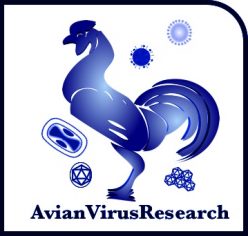Chicken anaemia virus (CAV) (aka chicken infectious anaemia virus) is an immunosuppressive gyrovirus, of the family Circoviridae, of high prevalence which causes severe anaemia, haemorrhages and immunosuppression in young chickens. Immunosuppressive sequelae of CAV infection reduce the efficiency of routine vaccinations while aggravating the effects of other pathogens, causing considerable economic losses to the poultry industry (1). It has never been implicated in pathogenesis in humans or other mammals but the genomes of related gyroviruses have been reported in human faeces and skin (2).
Genome organization and viral proteins
CAV has a small circular single-stranded DNA genome (3.8kb) encoding three open reading frames for a single structural protein, VP1, and two non-structural proteins, VP2 and VP3. A non-coding region contains regulatory elements (transcription factor-binding motifs). The small genome size of CAV means that it must be particularly dependent on host functions to complete its normal replication cycle. VP2 is a dual specificity protein tyrosine phosphatase (3) and VP3 or “apoptin” induces apoptosis in various human tumour and transformed cells (4). It has been suggested that apoptosis induced by this protein is responsible for the lymphoid depletion caused by CAV infection (5). VP3 phosphorylation at Thr108 is important for the nuclear localisation and cell killing ability of apoptin (6). However, the mechanisms of apoptin-induced cell death and the role of VP2 in the infection/replication process are not yet clear.
Transmission
Chickens can be infected with CAV both vertically and horizontally (7). Subclinical disease of commercial broilers due to CAV is more common than clinical disease (8). Vertical transmission causes clinical disease in young chicks at 10-14 days of age resulting in immunosuppression. In the developed world, clinical disease is now controlled by ensuring that breeder flocks have sero-converted before they come into lay, either by natural infection or vaccination. Protection of the newly-hatched chick is therefore through maternally-derived antibody (MDA). Once MDA has waned (2-3 weeks), CAV can transmit horizontally resulting mainly in sub-clinical disease. Sub-clinical disease has economic and health and welfare consequences, leading to higher feed conversion ratios, lower body weight and, therefore, lower income (8).
Pathogenicity
CAV targets lymphoid and erythroblastoid progenitor cells; apoptosis of the precursor haemocytoblast cells leads to a decrease of erythrocytes, thrombocytes and granulocytes, resulting in anaemia, haemorrhages and secondary infections due to immunosuppression (9-11). Other sites of CAV replication are the precursor T cells in the cortex of the thymus, CD8 cells in the spleen and to a lesser extent the bursa of Fabricius (9). Within 3-4 days post-infection (dpi), viral antigens can be isolated in the bone marrow, while maximal T cell depletion of lymphoid organs, and especially depletion of the thymic cortex, takes place at 10-14 dpi (5,12).
In the embryo model (3), CAV causes thymic depletion, down-regulation of expression levels of pro-inflammatory cytokine mRNA in the infected thymus (possibly explaining the lack of an inflammatory response to CAV infection) and down regulation of Major Histocompatibility Complex (MHC) Class I mRNA expression levels, despite up-regulation of type I interferon (IFN) mRNA expression levels (presumably thereby decreasing the infected thymocytes’ ability to present viral antigen to any responding cytotoxic T cells). From microarray studies13, genes that exhibited significant (>1.5-fold, fdr<0.05) changes in expression in thymus and bone marrow on CAV infection were mainly associated with T cell receptor signalling, immune response, transcriptional regulation, intracellular signalling and regulation of apoptosis. Expression levels of a number of adaptor proteins, such as src-like adaptor protein (SLA), a negative regulator of T cell receptor signalling and the transcription factor Special AT-rich Binding Protein 1 (SATB1), were significantly down-regulated (13).
Vaccination
Currently broilers and layer pullets are not commonly vaccinated against CAV in the field. Early protection is achieved by vaccination of the breeders though maternally derived antibodies. Breeders are vaccinated during the rearing period between 8-16 weeks of age with a live vaccine. Inactivated vaccines are still used in several countries.
Contributed by: Efstathios Giotis (Imperial College London)
Copyright © 2016 Efstathios S. Giotis
First posted: 19-Aug-2016
References
1 Todd, D. Avian circovirus diseases: lessons for the study of PMWS. Veterinary Microbiology 98, 169-174 (2004).
2 Zhang, X. et al. Phylogenetic and molecular characterization of chicken anemia virus in southern China from 2011 to 2012. Sci Rep 3, 3519 (2013).
3 Peters, M. A., Browning, G. F., Washington, E. A., Crabb, B. S. & Kaiser, P. Embryonic age influences the capacity for cytokine induction in chicken thymocytes. Immunology 110, 358-367 (2003).
4 Danen-Van Oorschot, A. A. et al. Apoptin induces apoptosis in human transformed and malignant cells but not in normal cells. Proceedings of the National Academy of Sciences 94, 5843-5847 (1997).
5 Jeurissen S H , F. W., J M Pol, A J van der Eb, and M H Noteborn Chicken anemia virus causes apoptosis of thymocytes after in vivo infection and of cell lines after in vitro infection. Journal of Virology 66, 7383-7388 (1992).
6 Rohn, J. L. et al. A tumor-specific kinase activity regulates the viral death protein Apoptin. The Journal of Biological Chemistry 277, 50820-50827 (2002).
7 Hoop, R. K. Persistence and vertical transmission of chicken anemia agent in experimentally infected laying hens. Avian Pathology 21, 493-501 (1992).
8 McNulty, M. S. Chicken Anemia Agent – A review. Avian Pathology 20, 187-203 (1991).
9 Adair, B. M. Immunopathogenesis of chicken anemia virus infection. Developmental & Comparative Immunology 24, 247-255 (2000).
10 Miller, M. M. & Schat, K. A. Chicken infectious anemia virus: an example of the ultimate host-parasite relationship. Avian diseases 48, 734-745 (2004).
11 Noteborn, M. H. M. & Koch, G. Chicken Anemia Virus-infection-Molecular basis of pathogenicity. Avian Pathology 24, 11-31 (1995).
12 McKenna, G. F., Todd, D., Borghmans, B. J., Welsh, M. D. & Adair, B. M. Immunopathologic Investigations with an Attenuated Chicken Anemia Virus in Day-Old Chickens. Avian diseases 47, 1339-1345 (2003).
13 Giotis, E. S. et al. Transcriptomic Profiling of Virus-Host Cell Interactions following Chicken Anaemia Virus (CAV) Infection in an In Vivo Model. PLoS One 10, e0134866 (2015).
